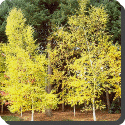 Birch Paper — Betula papyrifera (Paper Birch, also known as American White Birch and Canoe Birch) is a species of birch native to northern North America, from Newfoundland west to Alaska, south to Pennsylvania and Washington, with small isolated populations further south in mountains to North Carolina and Colorado.
Birch Paper — Betula papyrifera (Paper Birch, also known as American White Birch and Canoe Birch) is a species of birch native to northern North America, from Newfoundland west to Alaska, south to Pennsylvania and Washington, with small isolated populations further south in mountains to North Carolina and Colorado.
It is a medium-sized deciduous tree reaching 20 m tall (exceptionally to 35 m) with a trunk up to 80 cm diameter. The bark is white, commonly brightly so, flaking in fine horizontal strips, and often with small black marks and scars. In individuals younger than five years the bark appears brown with white lenticels, making the tree much harder to distinguish from other trees. The leaves are alternate, ovate, 5-12 cm long and 4-9 cm broad, with a doubly serrate margin. The leaf buds are conical and small, they are green colored with brown edges. The flowers are wind-pollinated catkins 3-8 cm long growing from the tips of twigs, the fruit matures in the fall. The mature fruit is composed of numerous tiny winged seeds packed between the catkin bracts. They drop between September and spring.
Betula papyrifera is a pioneer species. It needs high nutrients and a lot of sun. Birch bark is a winter staple food for moose. The nutritional quality is poor, but is important to wintering moose because of its sheer abundance. Although white-tailed deer consider Birch a “secondary-choice food”, it is an important dietary component. In Minnesota, white-tailed deer eat considerable amounts of paper birch leaves in the fall. Snowshoe hares browse paper birch seedlings, porcupines feed on the inner bark and mice eat the seeds. The leaves of the Paper Birch serve as food for various Lepidoptera.
Betula papyrifera has a soft, yet moderately heavy, white wood. It makes fine firewood. It is acceptable for furniture parts, floors, and Oriented Strand Board. It does not have a very high economic value. The sap can be used to produce birch syrup. The bark is also flammable even when wet which makes it very useful when on the trail.
 Kids Portal For Parents India Kids Network
Kids Portal For Parents India Kids Network






